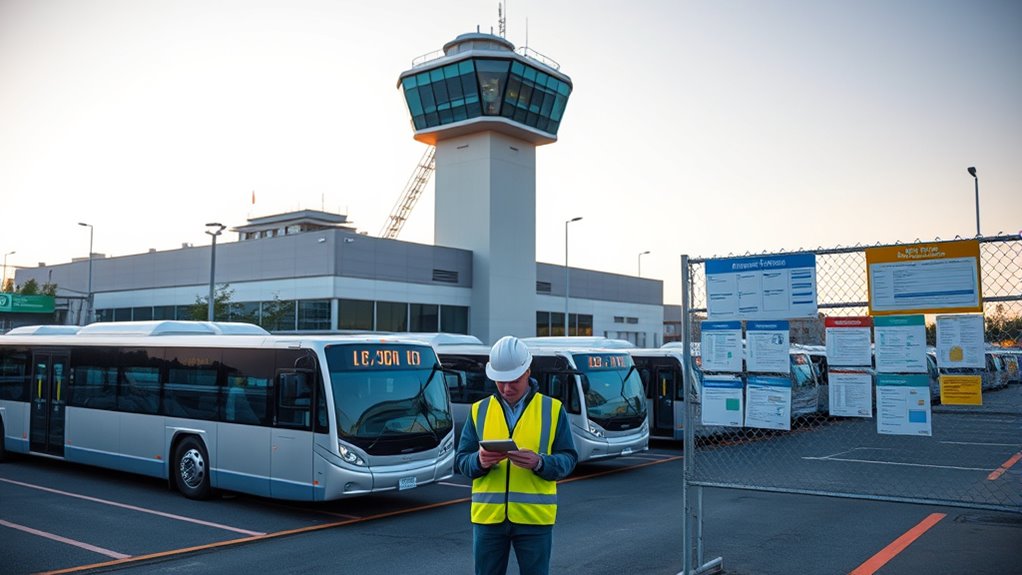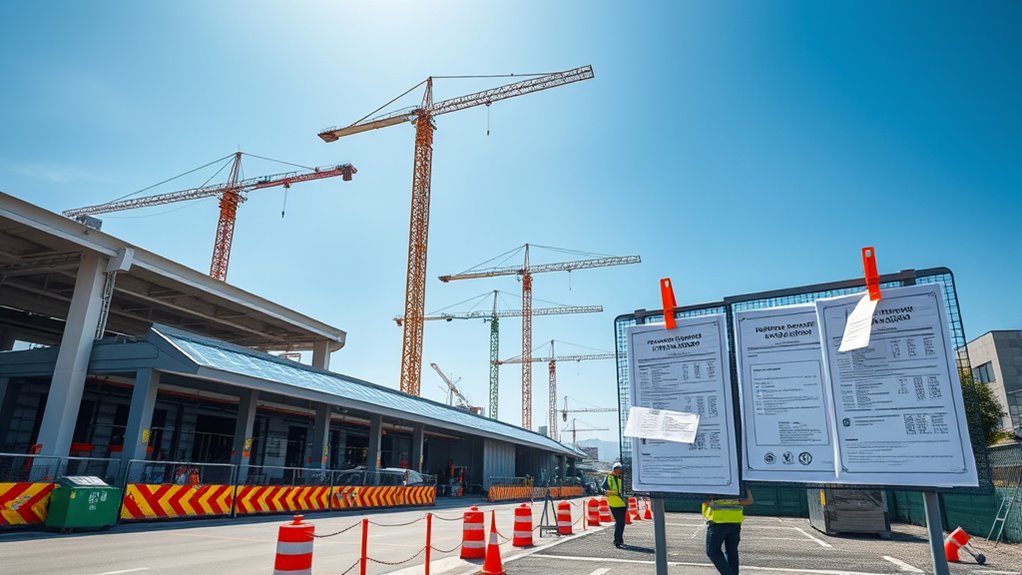To navigate permits and approvals for electric bus depots, streamline your process by advocating for digital, expedited permits and clear application guidelines. Familiarize yourself with local regulations and leverage “right-to-charge” laws to ease installation. Engage the community early and conduct thorough environmental assessments to smooth approval. Careful planning of energy supply and location will minimize delays. Continuing with these strategies can help you understand how to efficiently secure the necessary permits and get your project underway.
Key Takeaways
- Streamline permitting by implementing digital systems, clear checklists, and early regulatory reviews to reduce delays in depot approvals.
- Leverage “right-to-charge” laws and local ordinances to facilitate faster permit issuance and minimize bureaucratic hurdles.
- Conduct comprehensive environmental and safety assessments early to address community concerns and expedite approvals.
- Align depot planning with urban development initiatives and integrate infrastructure sharing to optimize permit processes.
- Engage stakeholders early and ensure permit applications are complete and compliant with regulations to avoid approval delays.

Are you steering the complex process of obtaining permits and approvals for electric bus depots? It can feel overwhelming, but understanding the key steps and strategies can make it more manageable. One effective approach is to push for permitting streamlining. Expedited processes for EV charging stations are recommended to reduce delays and barriers. By advocating for simplified procedures, you can accelerate project timelines and minimize bureaucratic hurdles.
Streamline permitting for EV stations to accelerate project timelines and reduce bureaucratic delays.
It’s also essential to review existing regulatory frameworks. Making sure these are compatible with EV infrastructure development prevents unnecessary complications. Developing clear checklists and guidelines for permit applications can further enhance efficiency. These tools help you understand exactly what’s required, avoiding delays caused by incomplete or incorrect submissions.
In most cases, permit approvals primarily involve health and safety reviews, which can be expedited when documentation is thorough and well-prepared. Allowing administrative approvals for compliant EV charging stations simplifies the process and saves time, especially when stations meet all safety and technical standards. Conducting comprehensive regulatory review early in the planning process can help identify potential issues before they cause delays. Additionally, integrating permitting procedures with broader urban planning initiatives can facilitate smoother project approvals. Incorporating digital permitting systems can also increase transparency and reduce processing times.
Legal and policy considerations also play a significant role. Some jurisdictions have adopted “right-to-charge” laws, making it easier to install charging stations without excessive legal hurdles. City ordinances may also be in place to speed up permit issuance, so staying informed about local regulations is essential.
Exempting EV charging stations from association approval can substantially cut bureaucratic delays, especially in areas with homeowners’ associations or similar bodies. Implementing online permitting systems enhances transparency, allowing you to track applications and understand requirements in real-time. Legislative support at both local and national levels further facilitates infrastructure development by providing clear legal backing and funding opportunities.
Environmental and social factors should never be overlooked. Conducting environmental impact assessments helps identify potential issues related to depot locations and operations, ensuring sustainability and community acceptance. Choosing locations that minimize visual and noise impacts increases public support and reduces opposition.
Detailed risk assessments, including fire safety and flooding risks, are essential to safeguard both the infrastructure and surrounding communities. Engaging with local residents and stakeholders early in the planning process fosters community involvement and helps address concerns proactively. Collaborative solutions can resolve complex environmental and social challenges, streamlining approval processes and building trust.
Finally, infrastructure and capacity planning are critical. Carefully planning energy supply and grid integration ensures sufficient capacity for current and future needs. Designing depots with scalability in mind accommodates fleet growth without requiring extensive new permits later. Incorporating high-quality project management can further streamline approval workflows and project execution.
Strategic depot locations can minimize logistical challenges and maximize operational efficiency. Sharing infrastructure with other energy users can reduce costs and improve utilization. By thoroughly considering these aspects, you position your project for smoother permit acquisition and successful deployment, bringing electric bus depots closer to reality.
Frequently Asked Questions
How Long Does the Permit Approval Process Typically Take?
You’re likely wondering how long the permit approval process takes. Generally, it varies based on the project size and location.
For small installations, approvals can be quick—sometimes same-day or within a few hours.
Larger projects may need 20 to 40 days or more, especially if multiple departments review your application.
Expedited processes and online systems can speed things up, but always check your local jurisdiction’s specific timelines to plan accordingly.
Are There Specific Environmental Regulations for Electric Bus Depots?
You need to follow specific environmental regulations for electric bus depots. These include conducting noise, land use, and emissions evaluations, especially if your depot is near residential areas.
You must also guarantee compliance with safety protocols for energy storage systems, like fire suppression and thermal management.
Additionally, utilities may require load studies, and you’ll need hazardous material plans for battery disposal.
Meeting these regulations helps you avoid delays and ensures environmental safety.
What Are the Common Challenges in Obtaining Permits?
You often face challenges like variable permitting timeframes across jurisdictions, which can delay your project. Lack of local experience with EV infrastructure complicates approvals, and securing access to right-of-way and easements can be difficult.
Additionally, coordinating with utilities for grid capacity and upgrades takes time. These hurdles require patience, proactive communication, and thorough planning to guarantee your project moves forward smoothly.
Can Permits Be Expedited for Urgent Projects?
Yes, permits can be expedited for urgent projects. You can utilize expedited permit services, which leverage local regulatory knowledge and maintain strong relationships with officials to speed up approvals.
Many cities offer online applications, over-the-counter permits, or express options that streamline the process. Though these services usually come with extra fees, they help you meet tight deadlines, minimize delays, and keep your project on schedule efficiently.
How Do Local Zoning Laws Impact Depot Approval?
You need to understand that local zoning laws greatly influence depot approval. They determine where depots can be built, whether as permitted or conditional uses, and specify requirements for height, setbacks, and parking.
Zoning classifications also differentiate between accessory and primary uses, affecting permitting pathways. Adhering to these laws helps streamline approvals, avoids delays, and ensures your depot aligns with regulations, especially in mixed-use or environmentally sensitive areas.
Conclusion
Managing permits for electric bus depots might seem complex, but with proper planning, you’ll streamline the process. Did you know that the global electric bus market is projected to grow at a CAGR of over 22% through 2030? Embracing this shift not only helps you stay compliant but also positions your fleet at the forefront of sustainable transportation. Stay informed, follow the regulations, and you’ll pave the way for a cleaner, greener future for your community.









